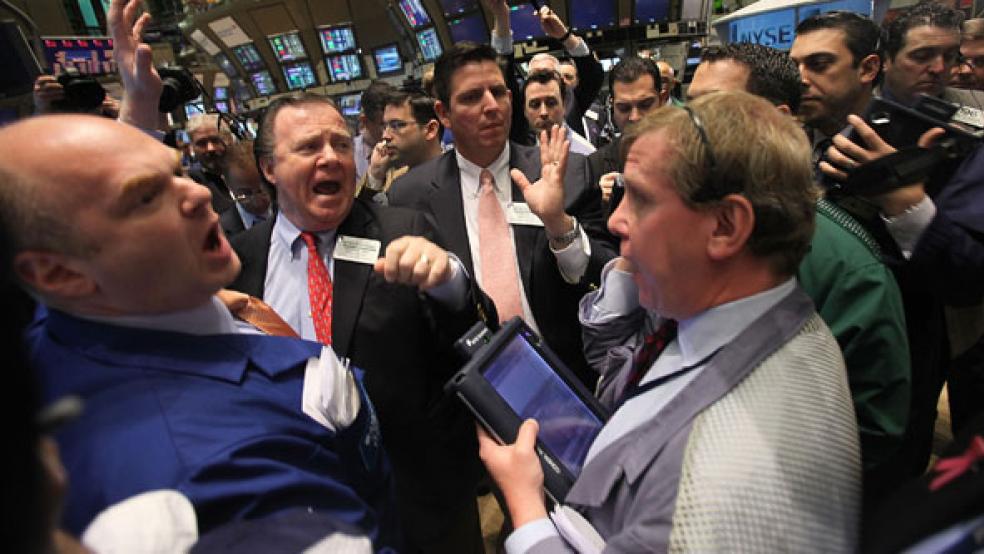September was supposed to be a lousy month for stocks, but investors cast off their risk aversion like some ratty old coat after Fed Chairman Ben Bernanke made clear his willingness to rev up the printing presses again, and the odds improved for a wave election that would usher in a more pro-investment policy mix in Washington. Since the end of August, the S&P 500 has risen 10 percent.
Now, investors, many of whom have been on the sidelines since the stock market started rising in March 2009, are back with a vengeance. And why not? After all, the expectation is that the Fed will begin its second round of easing at its November 2-3 meeting, and markets have historically done well after midterm elections. The average gain in the S&P 500 in the 12 months following midterm elections since 1950 has been 17 percent.
Still, there’s reason to be wary when almost everyone seems bullish – and on the same side of the trade. Some veteran investors are beginning to warn that the time is ripe for a pullback, at least a temporary one.
Here are four scenarios, largely manufactured in our nation’s capital, which could spook the stock market before year end.
- 1. A smaller-than-expected Republican win at the polls. If you look at InTrade as a barometer of election expectations, investors are betting on a 55-seat pickup in the House, which would be the biggest gain since 1948, leaving the House solidly in Republican control. Meanwhile, InTrade is predicting an eight-seat gain in the Senate, leaving Democrats with a razor-thin hold on power. But President Obama’s whirlwind campaigning has begun to shrink the enthusiasm gap between Democratic and Republican voters. If that trend continues, and the GOP pickup is significantly less than expected, that could sour investors’ moods.
- 2. Lame duck gridlock. Even if the Republicans regain the House, the lame duck session could prove inconclusive on key issues of concern to investors, notably the extension of the Bush-era tax cuts. Remember, the lame duck session is made up of the current Congress plus a few new Senators. The most likely scenario is that the lame ducks will kick the can down the road with a temporary extension of the Bush tax cuts, at least for the middle class. But if they fail to extend lower tax rates for upper-income people, dividends and interest could roil the markets, at least in the short term.
- 3. QE2. The widely held assumption is that the Fed will announce another round of quantitative easing at its November meeting. But despite that view, there are those at the Fed who question the wisdom of such a move as signs mount that the economy continues to recover. Among the dissenters: Kansas City Fed President Thomas Hoenig and Philadelphia Fed President Charles Plosser. That’s not to say the Fed won’t ease. Says Strategas analyst Jason DeSena Trennert, “At this point, the Fed almost can’t avoid additional quantitative easing – the only wiggle room left may simply be the size of the Fed’s purchases of Treasury securities.” The consensus now stands in the $500 billion to $1 trillion range of additional balance sheet expansion. But Trennert warns: “Anything less would represent a meaningful risk to the markets.”
- 4. The dollar. Stocks have been moving in virtual lockstep with the dollar: As it goes down, they go up. And vice versa. The dollar rose last week for the first time in six weeks after Treasury Secretary Timothy Geithner told The Wall Street Journal that he believes major currencies are "roughly in alignment now," suggesting he sees no need for further drops in the dollar. The recent rise in the dollar is likely to be short-lived, given the Fed’s apparent commitment to print more money. But comments like Geithner’s – and further strengthening of the dollar – could yet unsettle U.S. equity markets.
All this doesn’t mean the bull market, such as it is, is over. The tailwinds are still in tact: loose money, a likely wave election and a recovering economy. But there could be some Washington-generated whiplash ahead.




